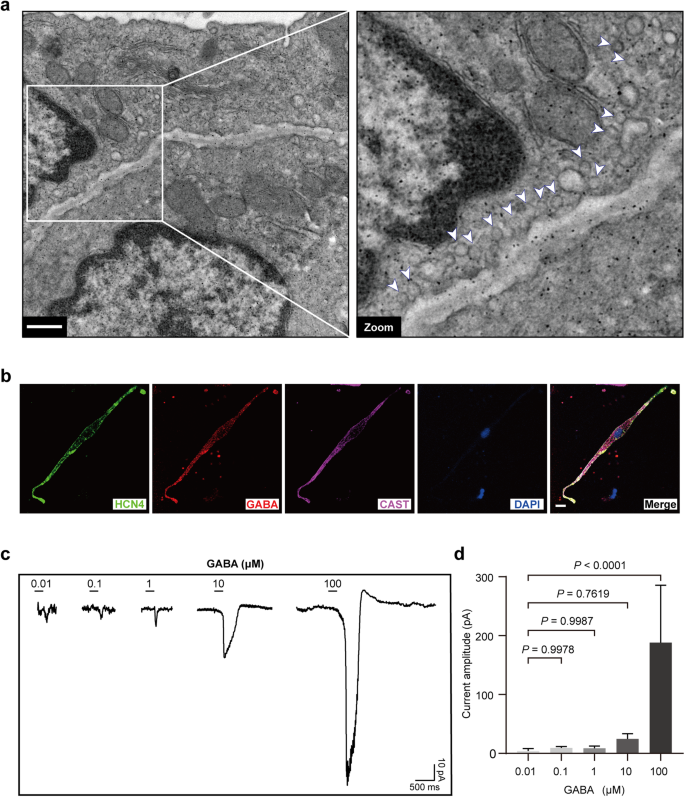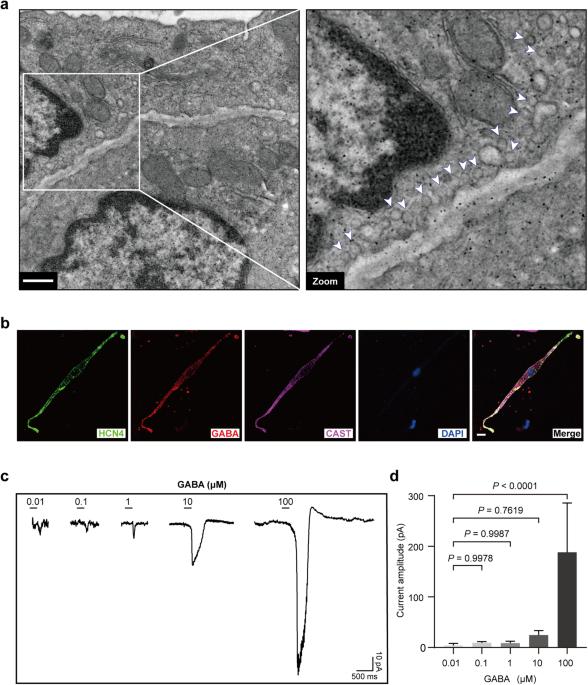房室结起搏细胞中的 GABA 能系统控制着心房和心室之间的电传导
IF 28.1
1区 生物学
Q1 CELL BIOLOGY
引用次数: 0
摘要
生理学上,心房先收缩,心室后收缩,这是正常血液循环的前提条件。上述房室顺序收缩的现象是由于房室结(AVN)的电兴奋在心房和心室之间的传导速度非常缓慢。然而,目前还不清楚是什么控制着房室结内电兴奋的传导。在这里,我们发现房室结起搏细胞(AVNPCs)具有完整的内在 GABA 能系统,它在从心房到心室的电传导中起着关键作用。首先,随着在 AVNPCs 表膜下发现大量含 GABA 的囊泡,GABA 能系统的关键元素,包括 GABA 代谢酶、GABA 受体和 GABA 转运体也在 AVNPCs 中被确定。其次,GABA 可同步激发 AVNPCs 中的 GABA 门控电流,从而显著削弱 AVNPCs 的兴奋性。第三,GABA能系统的关键分子元素明显调节了房室神经元电兴奋的传导性。第四,房室神经元中 GABAA 受体的缺乏会加速房室传导,从而损害房室神经元对快速心室频率响应的保护潜能,增加对致命性室性心律失常的易感性,并降低心脏收缩功能。最后,针对 GABA 能系统的干预措施可有效防止房室传导阻滞的发生和发展。总之,房室神经元中的内源性 GABA 能系统决定了房室神经元内电兴奋的缓慢传导,从而确保了房室收缩的连续性。内源性 GABA 能系统有望成为心律失常的新型干预目标。本文章由计算机程序翻译,如有差异,请以英文原文为准。


A GABAergic system in atrioventricular node pacemaker cells controls electrical conduction between the atria and ventricles
Physiologically, the atria contract first, followed by the ventricles, which is the prerequisite for normal blood circulation. The above phenomenon of atrioventricular sequential contraction results from the characteristically slow conduction of electrical excitation of the atrioventricular node (AVN) between the atria and the ventricles. However, it is not clear what controls the conduction of electrical excitation within AVNs. Here, we find that AVN pacemaker cells (AVNPCs) possess an intact intrinsic GABAergic system, which plays a key role in electrical conduction from the atria to the ventricles. First, along with the discovery of abundant GABA-containing vesicles under the surface membranes of AVNPCs, key elements of the GABAergic system, including GABA metabolic enzymes, GABA receptors, and GABA transporters, were identified in AVNPCs. Second, GABA synchronously elicited GABA-gated currents in AVNPCs, which significantly weakened the excitability of AVNPCs. Third, the key molecular elements of the GABAergic system markedly modulated the conductivity of electrical excitation in the AVN. Fourth, GABAA receptor deficiency in AVNPCs accelerated atrioventricular conduction, which impaired the AVN’s protective potential against rapid ventricular frequency responses, increased susceptibility to lethal ventricular arrhythmias, and decreased the cardiac contractile function. Finally, interventions targeting the GABAergic system effectively prevented the occurrence and development of atrioventricular block. In summary, the endogenous GABAergic system in AVNPCs determines the slow conduction of electrical excitation within AVNs, thereby ensuring sequential atrioventricular contraction. The endogenous GABAergic system shows promise as a novel intervention target for cardiac arrhythmias.
求助全文
通过发布文献求助,成功后即可免费获取论文全文。
去求助
来源期刊

Cell Research
生物-细胞生物学
CiteScore
53.90
自引率
0.70%
发文量
2420
审稿时长
2.3 months
期刊介绍:
Cell Research (CR) is an international journal published by Springer Nature in partnership with the Center for Excellence in Molecular Cell Science, Chinese Academy of Sciences (CAS). It focuses on publishing original research articles and reviews in various areas of life sciences, particularly those related to molecular and cell biology. The journal covers a broad range of topics including cell growth, differentiation, and apoptosis; signal transduction; stem cell biology and development; chromatin, epigenetics, and transcription; RNA biology; structural and molecular biology; cancer biology and metabolism; immunity and molecular pathogenesis; molecular and cellular neuroscience; plant molecular and cell biology; and omics, system biology, and synthetic biology. CR is recognized as China's best international journal in life sciences and is part of Springer Nature's prestigious family of Molecular Cell Biology journals.
 求助内容:
求助内容: 应助结果提醒方式:
应助结果提醒方式:


